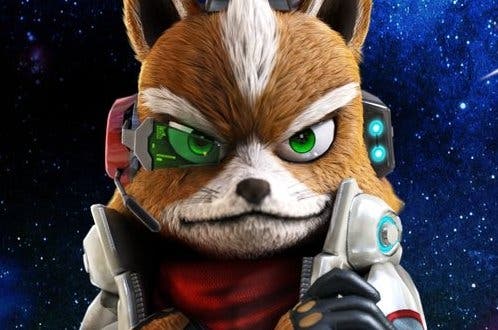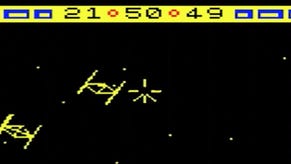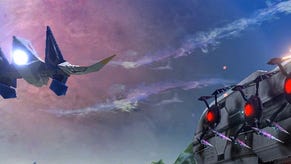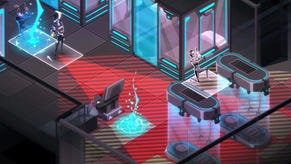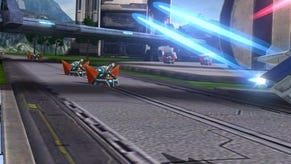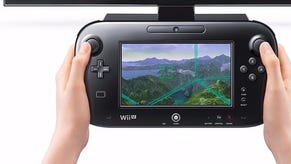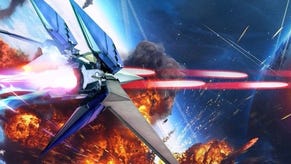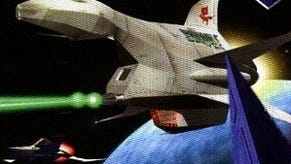Nostalgia and experiment meet in Star Fox Zero
Co-developed with Platinum Games.
It's a quiet Sunday morning in downtown Los Angeles, and while young men and women, some wearing Mario beach towels as capes, queue to be admitted to the Nintendo World Championships fan event - which I later gather from Twitter to be a roaring, feelgood success - a handful of press have been assembled at the back entrance to the Nokia Theater for a different purpose. We're here to get a preview of this morning's Digital Event, to hear from Shigeru Miyamoto about the headlining Wii U game Star Fox Zero, and to play it ourselves.
There's no disguising the awkward situation Nintendo finds itself in this year, and Nintendo's American chief Reggie Fils-Aime grabs the bull by the horns (watch out, bull) in the video when he says that we'll hear more about mobile gaming, theme parks and Nintendo's next console, NX, next year. We are in a holding pattern, and the wonderful, misbegotten Wii U is a dead console walking. Nintendo's natural warmth, its relationship with its ardent fans, make it easy for the firm to style it out - as the Championships prove to perfection - but we're here on business, and business is... oh, hey, look, a KK Slider Amiibo!
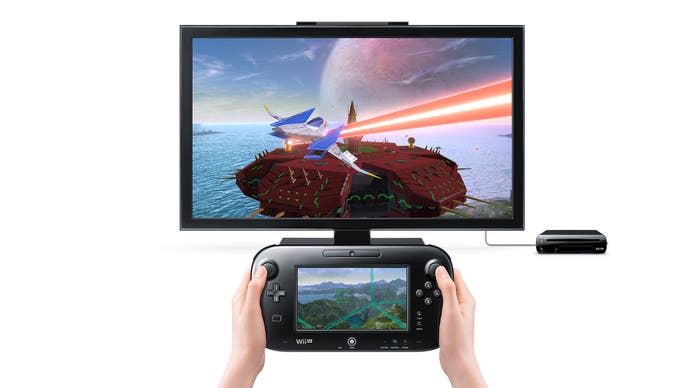
Perhaps the most telling sign that the company's focus is elsewhere is in the lack of major games from its in-house teams. Star Fox Zero, despite being the star of Nintendo's E3 a long-awaited return for this series of rollicking Saturday-matinee shoot-'em-ups, doesn't quite count. Debuting at last year's E3 as a sort of playable doodle from Miyamoto's sketchpad, in the intervening year it has been realised with efficiency and speed in a collaborative development with Platinum Games.
With its curious dual-screen set-up, it retains that sense of improvised experimentation from the original demo - but this isn't a farmed-out spin-off like Namco's Star Fox Assault for GameCube, or Q-Games' Star Fox Command for DS. This is a proper Star Fox game. So much so that you could initially take it for a remake of Star Fox 64: the first phase of the first stage on Corneria is a beat-fot-beat reprise of the opening of the Nintendo 64 game. "The overall structure is very similar, but the gameplay, bosses - lots of new content in there," Miyamoto says. You'll pilot alongside Slippy, Peppy and Falco through the scripted spectacle of on-rails sections and into 'all range mode' arena dogfights and boss fights across branching stages that will be worth re-visiting. The look is clean and bright, low-detail, almost retro, running at a smooth 60 frames per second on two screens, and the fizzing sound effects are exactly as you remember them.
But the gameplay, like the levels, soon starts branching off in multiple directions. Fox's Arwing fighter and Landmaster tank are back, but both can transform, the Arwing into a birdlike walker for ground combat and interior sections, and the Landmaster taking to the air as a chunky battlecruiser for a short period of time before its energy runs out. A more radical departure comes in the form of the Gyrowing: a hovering, helicopter-like craft that comes into play into some much more methodical, almost stealth-like stages in interior environments, which are all about cautious advance rather than the series' trademark headlong rush. Instead of transforming, the Gyrowing drops a tethered robot drone called the Direct-i (resembling the old ROB peripheral for the NES console) which can be used to explore even smaller spaces and and hack systems. Gyrowing stages are quite unlike anything you've played in Star Fox before.

The bigger change, though, comes in the controls and the dual-screen set-up. You pilot your Arwing with the two sticks, steering with the left, controlling speed and roll with the right (using a double flick for the famous barrel roll). But you aim your lasers by moving the target reticle with the Gamepad's gyro sensor, meaning you can now move and shoot in different directions. Over and above this, the Gamepad screen shows you a first-person cockpit view can differ from what's on the TV; you can still pilot and look around during cut-scenes and cinematic camera angles, aim to the left and right as your craft surges forward, or use lock-on targeting to keep track of enemy craft that are behind you on the TV while looking where you're going, and shooting, on the Gamepad.
"We're definitely going for a different feel where it's very cinematic, but you're able to control everything at the same time, so it's between a movie and a game," Miyamoto says. There are certainly some striking possibilities here; the dual set-up is perhaps most effective during a boss fight with a mothership when the TV presents a wide cinematic angle, keeping the whole battle in view, while you aim and fly on the Gamepad.
Splitting your focus in this way can be distracting and it takes a while to get an instinctive sense of where you should be looking, with the Gamepad providing finer aim and greater camera control, but the TV giving you the spatial awareness to save your ship from damage. Over a half-hour session I often found myself getting muddled, though never disastrously. The dual nature of the controls - moving your ship with sticks and buttons while you aim with movement - is another mental knot that will probably take a longer play session to properly disentangle so it feels natural.
It's rare that Nintendo's playful experiments with game controls don't work out, and the system offers a lot of finesse, depth and opportunity for showboating - that much was clear from watching the game's two young directors, Nintendo's Yugo Hayashi and Platinum's Yusuke Hashimoto (Bayonetta 2's director) - play. But it's not the immediately comfortable experience you might expect from such an indulgently nostalgic retread.
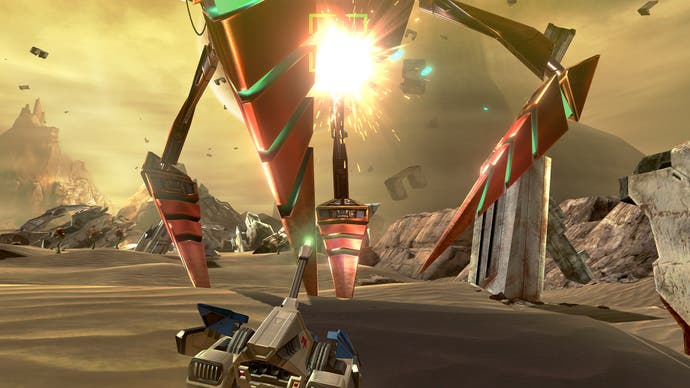
At a Q&A after our play-time, Miyamoto - still an impish and infectiously cheerful presence at 62, who gently rocks from his toes to his heels with restless energy - says the option to share development with Platinum presented itself naturally. "Nintendo's working hard in terms of partnerships with lots of different development companies to try and create as many different titles as possible," he says. "The way I think about this kind of development is, a small team can create the core of the game, and then we think about who we want to shop that out to. It was at this exact time last year, when we were showing off the Star Fox prototype, that Platinum Games was talking about wanting to put the Arwing in Bayonetta 2. And that project was wrapping up, so I thought, 'this could be good,' so I talked to Mr Inaba about getting a partnership going." He notes that Project Guard, another of his demos from E3 2014, is also being worked up into a full game at Platinum.
Platinum's aesthetic brio and taste for finessed, skilful action game systems is certainly a good fit for Star Fox. Noted Star Fox fan and Platinum superstar Hideki Kamiya isn't involved, though. "The only input from Mr Kamiya is, do your best!" says Hashimoto. "My background is in creating climax action scenes, so I like to think that we've put a lot of that element in."
Hashimoto is a quiet but enthusiastic young man who clearly relishes his working relationship with Miyamoto, although it's very different to what he's used to. "Mr Kamiya tends to get everything down in very very precise detail before moving forward, and... you can experience his attention to detail right through the game," he says. But Nintendo, Miyamoto in particular, have a much more improvisational approach. "My way of working adds a bit of immediacy to it" says the great designer, "so while the game is being programmed I'm always bringing new ideas, just writing them down on paper and passing them on to the programmers." He jokes, with visible pleasure, that they probably find this rather annoying.
In its current form, Star Fox Zero reflects this; it's perfectly stable and polished, of course - this is Nintendo after all - but it still feels like a rough assemblage of freshly-coded ideas, and some are working better than others. It doesn't have that obsessive Nintendo perfection, and it may never get it, despite its proud heritage and enormous fan appeal. It's a second-tier game filling in for an absent star (the next Zelda) on a struggling platform. But it still shows Nintendo thinking ahead and moving fast, driven by that stream of ideas out of Miyamoto's office, now filtering down to a new generation of designers both inside and outside its hallowed walls. And that can hardly be a bad thing.
